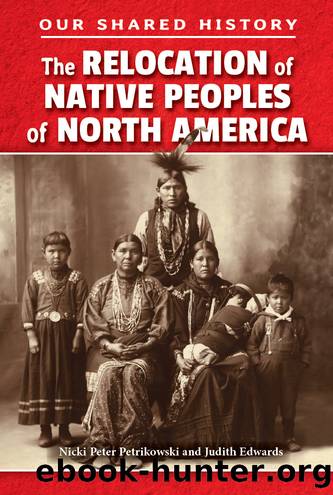The Relocation of Native Peoples of North America by Judith Edwards

Author:Judith Edwards
Language: eng
Format: epub
Publisher: Enslow Publishing, LLC
A Lakota Sioux camp near the Pine Ridge reservation in South Dakota.
This political cartoon shows the corrupt agent profiting while the Sioux Indian starves.
Pursued relentlessly after their victory at Little Big Horn, the Sioux ended up by losing a full third of their reservation and all their hunting rights in Montana and Wyoming. The next reduction came when settlers complained to the government about the Sioux reservation being in the way of their emigration to eastern Dakota. The Sioux were then forced to create a sixty-mile-wide corridor right through the middle and the farthest western portion of their reservation. The remainder was divided up into the five small reservations they occupy today. And that was not allâthe Dawes Act was enacted and the remaining reservation was divided into 160-acre parcels and what was left over was sold to whites.5
On the Sioux and almost all other reservations, Indians had no way to work or hunt for their own food. Many reservations had rules that would not allow American Indians to leave the boundaries. The reservation Indians became totally dependent on government rations. They lost a sense of purpose, hope, and self-esteem and were reduced often to begging and petty stealing just to fill their stomachs. They suffered tuberculosis and other diseases, malnutrition, and alcoholism. The government rations were often cut in half or replaced with spoiled food and shoddy goods because of widespread corruption among officials and agents employed by the Bureau of Indian Affairs. Though there were a few good and honest agents, they were often removed because the middlemen who supplied the reservations wanted to continue to put the money in their own pockets.
Economic Difficulties
Reservations became places of chronic poverty, with no work available. âIn the decade after the Civil War, behind-the-scenes corruption in the Indian Bureau went from bad to worse,â says Peter Nabokov.6 Members of Congress, dishonest suppliers of the food and other goods, and Indian agents often came up with schemes to divert the money owed to the reservations.
In 1867 a group of citizens from the Eastern states formed the Indian Peace Commission, to find out if the shocking rumors of poverty and poor health on the reservations were true. In 1871 President Grant launched a similar investigation through the Board of Indian Commissioners, which would oversee the Bureau of Indian Affairs. These civilian groups discovered that many of the Indians were near starvation because corrupt agents had stolen the money allocated for buying supplies for the reservation.
Download
This site does not store any files on its server. We only index and link to content provided by other sites. Please contact the content providers to delete copyright contents if any and email us, we'll remove relevant links or contents immediately.
This Is How You Lose Her by Junot Diaz(6440)
The Kite Runner by Khaled Hosseini(4952)
The Mayflower and the Pilgrims' New World by Nathaniel Philbrick(4281)
Bloody Times by James L. Swanson(4242)
Pocahontas by Joseph Bruchac(4028)
Flesh and Blood So Cheap by Albert Marrin(3670)
An American Plague by Jim Murphy(3630)
The 101 Dalmatians by Dodie Smith(3300)
Hello, America by Livia Bitton-Jackson(3013)
Finding Gobi by Dion Leonard(2634)
Harry Potter and the Half-Blood Prince (hp-6) by J. K. Rowling(2369)
The Impossible Rescue by Martin W. Sandler(2212)
See You in the Cosmos by Jack Cheng(2078)
I Will Always Write Back by Martin Ganda(2037)
Bloody Times: The Funeral of Abraham Lincoln and the Manhunt for Jefferson Davis by James L. Swanson(1983)
When Dimple Met Rishi by Sandhya Menon(1934)
The Queen of Attolia by Megan Whalen Turner(1922)
The Crossover by Kwame Alexander(1850)
Hoodoo by Ronald L. Smith(1794)
